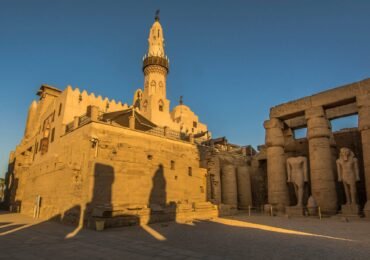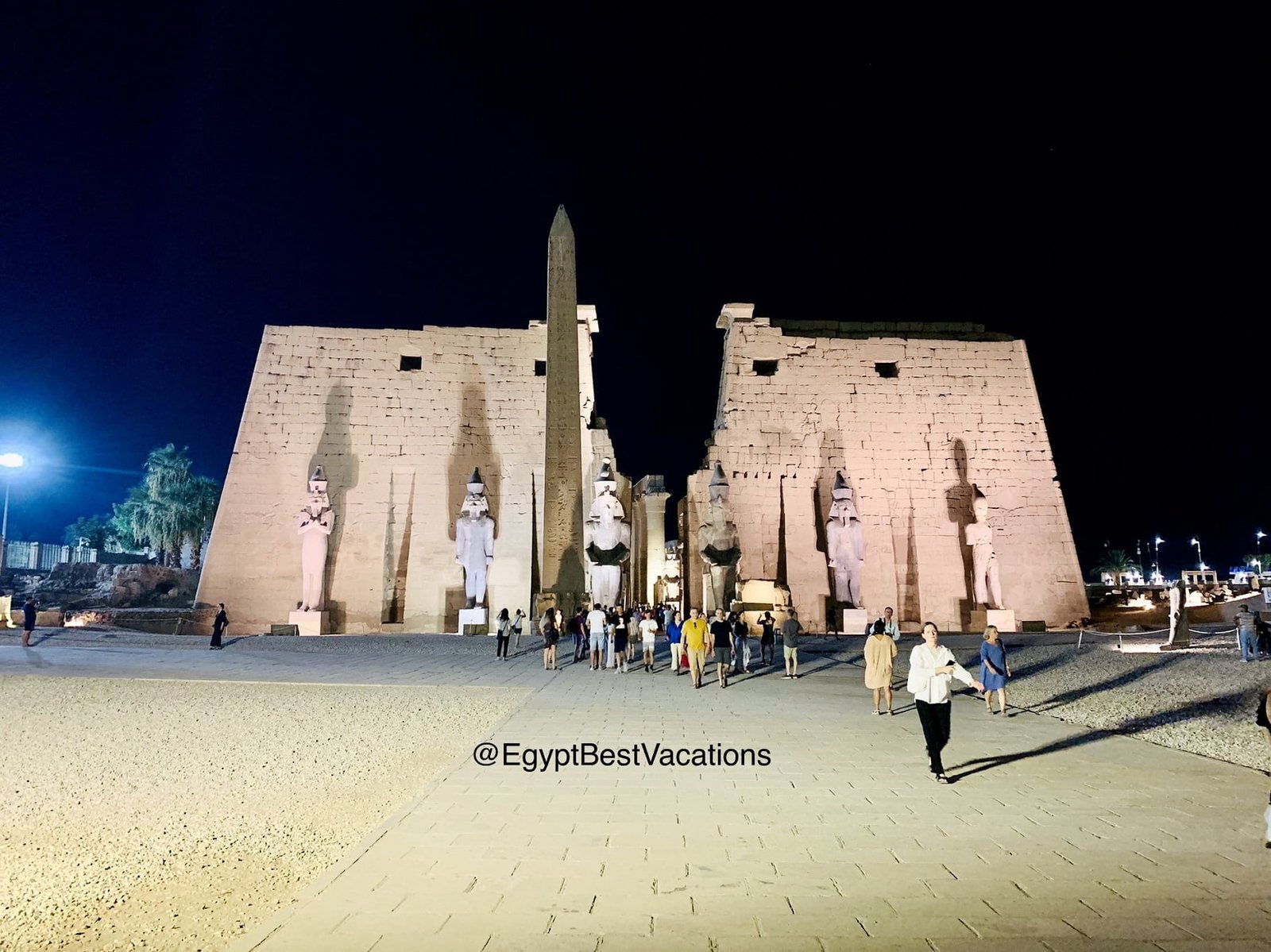Secrets Unearthed at Luxor Temple
Luxor Temple was built by the pharaoh Amenhotep III (1387-1349 BCE), the grandson of the military genius Tuthmosis III. It was expanded by the 19th Dynasty pharaoh Ramses II (1279-1213 BCE). Numerous other sovereigns, including Tutankhamun, Horemhab, and Alexander the Great enriched the construction with reliefs, inscriptions, and minor buildings.
Luxor Temple together with the Karnak Temple was built for the glory of Amun-Re, King of the gods. So, the temple was known by the Ancient Egyptians as the “Southern Harem of Amun”. Most of the temple complex is well preserved, particularly the wall reliefs. As it was covered in sand and built over by the town until excavations started in 1885 by Gaston Maspero. The structure of Luxor Temple follows the classic of the pharaonic temples. A pavement progressively rises and the roof declines from the entrance to the inner sanctuary.
Only the Pharaoh or the High Priest was permitted to enter the sanctuary and behold the statue of the deity. Nowadays the temple lies in the heart of of the city of Luxor. Every so often from the setting for a production of Verdi’s Aida (performed last year, 2019, at Hatshepsut Temple).
First Pylon (Ramses II’s Pylon):
Karnak Temple was joined to the Luxor Temple by the avenue of sphinxes which leads straight up to the entrance pylon of Luxor Temple. The pylon is decorated with reliefs of Ramses II’s victory in the Battle of Qadesh (as he claimed). On the left side of the pylon are the Egyptian camp and the war council. While on the right side is the Battle of Qadesh. Below, in vertical bands of inscribed hieroglyphs, is the so-called Poem of Pentaur, which celebrates the pharaoh’s courage. Four large vertical slits on the façade were meant to hold the flagstaffs.

Fronting the pylon are two seated colossi of Ramses II, and 4 standing ones (some of which were restored recently). Four baboons support a superb obelisk (25m tall), the twin of which has adorned the Place de la Concorde in Paris since 1836. Mohamed Ali Pasha had gifted it to the Queen of France. In return, the Queen of France had gifted Mohamed Ali a clock that adorns his White Mosque at the Citadel of Saladin in Cairo.
Ramses II’s Open Court:
The pylon leads to the Court of Ramses II surrounded by two rows of papyrus-bud columns, and statues of Ramses II in the intercolumnar space. Perched high up to the left of the court, and easily missed at first, is the Mosque of Abu Al-Haggag. The patron saint of Luxor, who is buried on the site.
On the western wall of the court is a beautiful relief of a funeral procession led by 17 of Ramses II’s 100 or so sons. While on the northwest side of the court is the shrine of the sacred barks. It was built during the time of Hatshepsut and is dedicated to the Theban Triad of Amun, Mut, and Khonsu.
Plan your trip: Luxor full-day tour to East and West banks
Mosque of Abu Al-Haggag in Luxor Temple:
Founded in the 12th century by the Sufi mystic Abu Al-Haggag. The mosque was built when Luxor Temple was almost completely covered in silt and sand. When excavations began on the temple, and houses were cleared away. Local people refused to allow any disturbance of the mosque. Since the picturesque mosque hangs about 13 meters above ground level, with its foundations exposed.

An annual Sufi mawlid (birthday festival) is held every year during the month of Sha’aban (the 8th month of the Islamic calendar) to celebrate the saint’s day. This is the largest festival in Upper Egypt.
Luxor Temple Colonnade of Amenhotep III:
A portal (original entrance of the temple) leads from Ramses’s Court into the impressive Colonnade of Amenhotep III. The colonnade is of exquisite proportions and a fine example of the architecture of this period. It is made of two rows of seven columns.
The reliefs on its walls, dating from the time of Tutankhamun (1333-1323 BCE) depict the great Opet festival that took place each year at the height of the flood. During the festival, the sacred statue of the god Amun-Re was taken out of the sanctuary at Karnak. Amidst great pomp and ceremony is transported in a scared barge to Luxor Temple to be reunited with the statues of his consort Mut and their son Khonsu. It remained here for a few days of celebrations and festivities, before being returned to Karnak Temple.

The occasion offered the people of Thebes a rare opportunity to glimpse the statue of Amun-Re. A chance repeated at the end of the year when a second festival (Valley Festival) was held. In this Valley Festival, Amun-Re was carried across the Nile to visit the mortuary temples of the pharaohs on the west bank of Luxor.
Return of Opt Festival to Karnak:
Reliefs illustrating preparations for the Opet festival can be seen on the right-hand wall of Amenhotep III’s Colonnade (some of which was restored in the 1970s), including a rehearsal by dancing girls. They show the procession beginning at the gate of Karnak Temple, shown complete with flagstaffs, from which white-robed priests bear the sacred barge of Amun-Re down to the water’s edge. An enthusiastic audience claps hands in unison, and it is accompanied upstream by celebrates along the shore; a sacrifice of slaughtered animals is followed by a group of acrobats, and finally, offerings are made to the Theban Triad of Amun, Mut, and Khonsu at the Temple of Luxor.
On the opposite wall are scenes of the festival’s return procession. The barges are floated downstream, and the final sacrifice and offerings of flowers are made to the deities at Karnak Temple. At the beginning of the colonnade are two fine limestone groups of the pharaoh and a queen.
Plan your tour: Tour to Karnak & Luxor temples
The Court of Amenhotep III:
The colonnade gives access to the second court, or the Court of Amenhotep III. Lined on three sides by double rows of bundle columns with closed capitals.
An important discovery was made in the Court of Amenhotep III at the end of 1989. When flagstones were being lifted to check on the tilt of the land and possible undermining of the temple’s columns, archaeologists found a hidden cache containing, among other objects, life-size statues of various New Kingdom pharaohs. Many of them are displayed in the New Hall of the Luxor Museum.
The Hypostyle Hall of Amenhotep III:
The fourth side of the court is actually a transversely-placed Hypostyle Hall with four rows of eight columns each, of the same type as those in the courtyard. Beyond this hall are several chambers, some of which were adopted by the Roman into Roman chapels and churches. Alexander the Great added a small chapel with reliefs of himself as an Egyptian.
Birth Room (Mamisi) of Amenhotep III:
Other rooms open off around the sanctuary of Luxor Temple, like the interesting Birth Room of Amenhotep III. With relief decorations chronicling the divine conception and birth of the king. Amun speaking with Thoth, with the pharaoh, and with the queen. Khnum fashioning two new-born figures on his potter’s wheel (Amenhotep III and his Ka (spirit). Thoth announce to Mutemuya, mother of Amenhotep III, that she has conceived. Mutemuya, pregnant, being taken before Isis and Khnum; Mutemuya on her bed, assisted by the deities of childbirth; the nursing of the infant and his presentation to Amun.
Plan your tour: Luxor day trip from Cairo by plane
The Holy of Holies:
Behind the sanctuary, is the Holy of Holies, which was inaccessible to common mortals and the majority of the priests. Here was kept the statue of Amun, into his presence only the pharaoh and the High Priest was allowed to come for the purpose of celebrating the liturgical ceremonies.
How to Get to Luxor Temple from Luxor:
Getting to Luxor Temple from various parts of Luxor city is straightforward and convenient. Here are some common ways to reach Luxor Temple:
Walking:
If you are staying within the city center or near the Nile Corniche, walking to Luxor Temple is a pleasant option. The temple is centrally located and easily accessible on foot. Simply follow signs or ask locals for directions to the temple.
Taxi:
Taxis are readily available throughout Luxor. Simply hail a taxi on the street or ask your hotel to call one for you. Most drivers know the way to Luxor Temple, and the ride should be quick and affordable. Always ensure the driver uses the meter or agree on a fare before starting the journey.
Horse-Drawn Carriage (Caleche):
For a more unique experience, consider taking a horse-drawn carriage, known locally as a caleche. These carriages are a popular mode of transport for tourists and offer a charming way to see the city. Negotiate the fare before starting your journey.
Public Transportation:
Local minibusses, known as “microbuses,” run routes throughout Luxor and can take you near the temple. Ask locals or your hotel staff for the nearest microbus stop and the route number that passes by Luxor Temple. This is the most economical option but might require some walking from the drop-off point.
Private Tour:
Egypt Best Vacations offers private tours that include transportation to and from Luxor Temple. These tours include a guide who can provide valuable insights into the temple’s history and significance.
Luxor Temple is an amazing temple and one of the must-see temples in Egypt, so we include it in all of our Egypt travel packages, as well as some of Luxor Day Tours.

